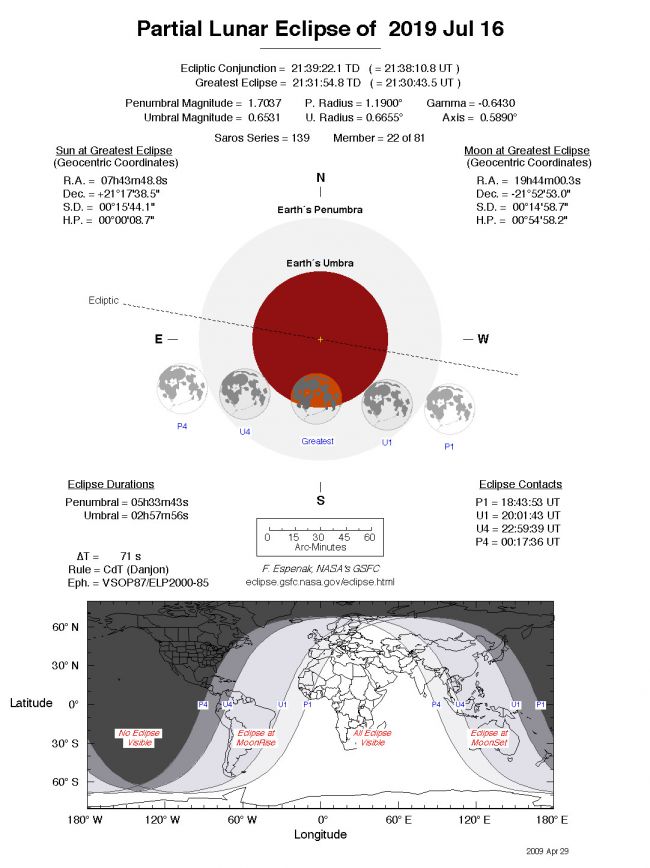Are you looking forward to watch the last lunar eclipse of the year? Don’t worry, because we got you covered even if you don’t live where the partial eclipse is visible.
What exactly is a Lunar Eclipse?
Lunar Eclipses is when the moon passes Earth’s shadow as it completes its orbit opposite to the planet, on the other side of the sun. The phenomenon can be easily understood by looking at the diagram below.
“Our next #LunarEclipse will occur on July 16–17, when the moon in Capricorn aligns perfectly with the sun in Cancer at 24 degrees. Remember, cosmic warriors, endings are hard, but everything is cyclical: A culmination always occurs on the edge of a beginning.”
♑️ 🌙 ♋️ 🌞 💫 🌑 pic.twitter.com/Ab5gM8Reye— 𝔄𝔫𝔞𝔰𝔱𝔞𝔰𝔦𝔞 (@xsiaxo) July 14, 2019
Eclipse times in Universal Time (July 16, 2019):
Partial umbral eclipse begins: 20:02 (8:02 p.m.) UTC
Greatest eclipse: 21:31 (9:31 p.m.) UTC
Partial umbral eclipse ends: 23:00 (11:00 p.m.) UTC
Local times of the eclipse for various localities:
Rio de Janeiro, Brazil
Moonrise (eclipse in progress): 5:19 p.m (July 16) local time
Greatest eclipse: 6:31 p.m. (July 16) local time
Partial lunar eclipse ends: 8:00 p.m. (July 16) local timeParis, France
Partial umbral eclipse begins: 10:02 p.m. (July 16) local time
Greatest eclipse: 11:31 p.m. (July 16) local time
Partial umbral eclipse ends: 1:00 a.m. (July 17) local timeNew Delhi, India
Partial umbral eclipse begins: 1:32 a.m. (January 17) local time
Greatest eclipse: 3:01 a.m. (July 17) local time
Partial umbral eclipse ends: 4:30 p.m. (July 17) local timeMelbourne, Australia
Partial umbral eclipse begins: 6:02 a.m. (July 17) local time
Greatest eclipse: 7:31 a.m. (July 17) local time
Moonset (eclipse in progress): 7:40 a.m. (July 17) local time

Lunar eclipses are quite often and take every few years and are visible in different parts of the world. However, today’s eclipse will be a partial lunar eclipse.

Full Lunar eclipses turn the moon into red because Earth completely blocks the sunlight reaching the soon but partial eclipse give different shades to the moon. As for today’s eclipse, astronomers predict that the colour of the moon will be red.
Since the moon has no light of its own, lunar eclipse can be safely viewed by the naked eye. If you want to take a closer look, consider using a binocular or a telescope. They are visible in any part of the world where the moon is visible, unlike solar eclipse.
With reasonably clear skies across the UK later this evening, you may be able to view the partial #LunarEclipse.
Maximum eclipse in London is at 22:30, with the partial eclipse ending around midnight 🌒 @BBCBreakfast @BBCRadio2 pic.twitter.com/hVKlElcKnR
— Matt Taylor (@MetMattTaylor) July 16, 2019
Even though it’s pretty difficult even for astronomers to predict the colour of the moon, some recent volcanic activity indicates that it could turn out to be a “half-blood moon“.
Let's hope for clear skies in your area on Wednesday night! #LunarEclipse
Read: https://t.co/FgNEuJ2N5x pic.twitter.com/iJtuZHbLgt
— Inquirer (@inquirerdotnet) July 16, 2019
Where can I watch the Lunar Eclipse?
Tonight’s eclipse is visible to a majority of the population on Earth and is can be viewed by people from Europe, Asia, Australia, Africa and Europe. The only exception is North America and some part of Russia and China.
If you live in the part of the world where the eclipse won’t be visible or would love to check out from the comfort of your bed/couch, no problem!
Space.com is doing a live webcast covering the eclipse in partnership with Slooh. Check it out from the link below:
The post Watch the Last Lunar Eclipse of 2019: Timings and locations appeared first on Hiptoro.
No comments:
Post a Comment